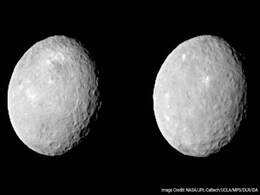Asteroid Vesta
- All
- News
-

NASA's Dawn Mission Unveils Insights into Vesta’s Mysterious Gullies Using Lab Simulations
- Tuesday December 24, 2024
- Written by Gadgets 360 Staff
NASA’s Dawn mission to the asteroid Vesta revealed mysterious gullies on its surface. New lab experiments, simulating Vesta's harsh vacuum conditions, suggest that liquid water, possibly briny, could have flowed briefly and carved these channels. These findings challenge existing theories about liquid stability on airless bodies and provide insig...
-
 www.gadgets360.com
www.gadgets360.com
-

11-Year-Old Mission Ends As NASA's Dawn Spacecraft Goes Silent
- Friday November 2, 2018
- Science | Indo-Asian News Service
NASA's Dawn spacecraft has gone silent, ending an 11-year-old historic mission to explore the two largest bodies in the main asteroid belt, Vesta and Ceres, the US space agency said.
-
 www.ndtv.com
www.ndtv.com
-

Bright Spots on Dwarf Planet Can Be Active Ice: NASA
- Wednesday March 18, 2015
- World News | Indo-Asian News Service
A pair of bright spots that glimmer inside an impact crater on the asteroid Ceres could be some kind of icy plume, new images from NASA's Dawn spacecraft have revealed.
-
 www.ndtv.com
www.ndtv.com
-

Nasa's Dawn Spacecraft Reaches Dwarf Planet Ceres for 16-Month Study
- Saturday March 7, 2015
- Written by HiteshA
The spacecraft made a 14-month tour of the asteroid Vesta before steering itself toward Ceres, the largest body in the asteroid belt between Mars and Jupiter.
-
 www.gadgets360.com
www.gadgets360.com
-

Nasa Probe Indicates Asteroid Vesta Once Had Flowing Water: Study
- Tuesday January 27, 2015
- Written by Vidhyanshu
"These results, and many others from the Dawn mission, show that Vesta is home to many processes that were previously thought to be exclusive to planets."
-
 www.gadgets360.com
www.gadgets360.com
-
1.7 billion miles from earth, NASA spacecraft orbits giant asteroid
- Tuesday July 19, 2011
- World News | Associated Press
NASA's Dawn spacecraft was captured into orbit around the massive asteroid Vesta after a 1.7 billion-mile (2.7 billion kilometer) journey and is preparing to begin a study of a surface that may date to the earliest era of the solar system, the space agency said on Monday.
-
 www.ndtv.com
www.ndtv.com
-

NASA's Dawn Mission Unveils Insights into Vesta’s Mysterious Gullies Using Lab Simulations
- Tuesday December 24, 2024
- Written by Gadgets 360 Staff
NASA’s Dawn mission to the asteroid Vesta revealed mysterious gullies on its surface. New lab experiments, simulating Vesta's harsh vacuum conditions, suggest that liquid water, possibly briny, could have flowed briefly and carved these channels. These findings challenge existing theories about liquid stability on airless bodies and provide insig...
-
 www.gadgets360.com
www.gadgets360.com
-

11-Year-Old Mission Ends As NASA's Dawn Spacecraft Goes Silent
- Friday November 2, 2018
- Science | Indo-Asian News Service
NASA's Dawn spacecraft has gone silent, ending an 11-year-old historic mission to explore the two largest bodies in the main asteroid belt, Vesta and Ceres, the US space agency said.
-
 www.ndtv.com
www.ndtv.com
-

Bright Spots on Dwarf Planet Can Be Active Ice: NASA
- Wednesday March 18, 2015
- World News | Indo-Asian News Service
A pair of bright spots that glimmer inside an impact crater on the asteroid Ceres could be some kind of icy plume, new images from NASA's Dawn spacecraft have revealed.
-
 www.ndtv.com
www.ndtv.com
-

Nasa's Dawn Spacecraft Reaches Dwarf Planet Ceres for 16-Month Study
- Saturday March 7, 2015
- Written by HiteshA
The spacecraft made a 14-month tour of the asteroid Vesta before steering itself toward Ceres, the largest body in the asteroid belt between Mars and Jupiter.
-
 www.gadgets360.com
www.gadgets360.com
-

Nasa Probe Indicates Asteroid Vesta Once Had Flowing Water: Study
- Tuesday January 27, 2015
- Written by Vidhyanshu
"These results, and many others from the Dawn mission, show that Vesta is home to many processes that were previously thought to be exclusive to planets."
-
 www.gadgets360.com
www.gadgets360.com
-
1.7 billion miles from earth, NASA spacecraft orbits giant asteroid
- Tuesday July 19, 2011
- World News | Associated Press
NASA's Dawn spacecraft was captured into orbit around the massive asteroid Vesta after a 1.7 billion-mile (2.7 billion kilometer) journey and is preparing to begin a study of a surface that may date to the earliest era of the solar system, the space agency said on Monday.
-
 www.ndtv.com
www.ndtv.com






